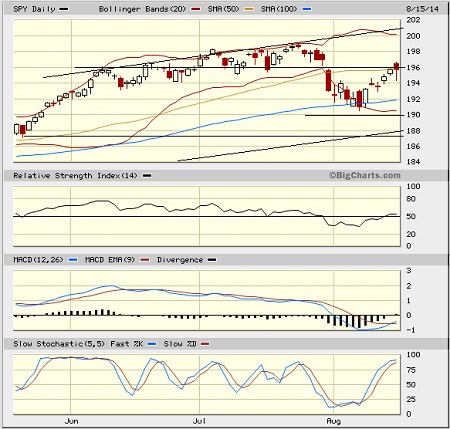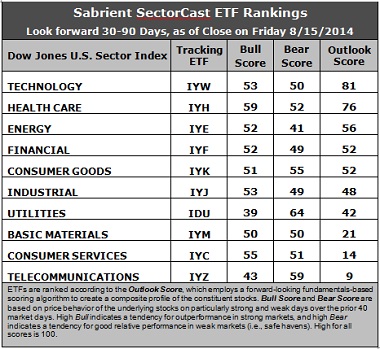Courtesy of Sabrient Systems and Gradient Analytics
 As many investors enjoy the final weeks of summer, some optimistic bulls seem to be positioning themselves well ahead of Labor Day in anticipation of a fall rally. Indeed, last week’s action was impressive. After only a mere 4% correction, investors continued to brush off the disturbing violence both at home and abroad, and they took the minor pullback as their next buying opportunity. But was that really all the pullback we’re going to get this year? I doubt it. But I also believe that nothing short of a major Black Swan event can send this market into a deep correction.
As many investors enjoy the final weeks of summer, some optimistic bulls seem to be positioning themselves well ahead of Labor Day in anticipation of a fall rally. Indeed, last week’s action was impressive. After only a mere 4% correction, investors continued to brush off the disturbing violence both at home and abroad, and they took the minor pullback as their next buying opportunity. But was that really all the pullback we’re going to get this year? I doubt it. But I also believe that nothing short of a major Black Swan event can send this market into a deep correction.
In this weekly update, I give my view of the current market environment, offer a technical analysis of the S&P 500 chart, review our weekly fundamentals-based SectorCast rankings of the ten U.S. business sectors, and then offer up some actionable trading ideas, including a sector rotation strategy using ETFs and an enhanced version using top-ranked stocks from the top-ranked sectors.
Market overview:
Looking at the ten U.S. business sectors, Technology, Utilities, and Healthcare each had a good week last week and are still the leaders year-to-date, while Energy fell back a tad. Notably, Basic Materials continues to show new life and is pulling away from the pack at the lower end of the performance scale — Industrial, Financial, Consumer Goods/Staples, Consumer Services/Discretionary, and Telecommunications.
U.S. Treasuries continue to enjoy strong demand, even while the Fed continues to taper its bond buying activity. The 10-year yield fell even further last week, closing Friday at 2.34%, and the 30-year last checked in at 3.13%. Again, the strength in Treasuries is reflecting global investors seeking the relative safety of the U.S., given all the global turmoil, as well as an expectation that the Fed likely will not raise interest rates any time soon. Low rates entice business to borrow for expansion, hiring, and stock buybacks, and they support higher equity valuation multiples when low bond yields (and a low discount rate) are compared with future earnings in equities discounted back to a present value.
The CBOE Market Volatility Index (VIX), a.k.a. fear gauge, closed Friday at 13.15. During the recent market pullback, VIX had spiked above 17, but soon fell back to as low as 12 on Friday morning during the early continuation of the market rebound. However, the Friday rumor regarding a direct Ukraine/Russia military confrontation gave the VIX an intraday spike near 15 before settling back down. I said last week that if the VIX can stay below 15, bulls should be able to make a good upside run, and indeed they have, certainly aided by some option-expiration-week short-covering.
Corporate earnings reports have been quite strong, and about two-thirds of the S&P 500 companies have beaten analyst estimates, which is a greater beat rate than normal. And rather than relying on cost-cutting and productivity gains, top-line revenue growth for 2Q 2014 was up +4.4% versus 2Q 2013 for the S&P 500 large caps and +2.7% for the 30 Dow Jones Industrials blue chips, while small caps overall have reported revenue growth of over +11%.
By the way, Sabrient’s Baker’s Dozen top stocks for 2014 appear to be making a move to pull away from the benchmark performance. Former laggard NetApp Inc. (NTAP) certainly helped the cause with a strong earnings report, and others among the laggards are starting to show some juice, including Huntington Ingalls Industries (HII), Marathon Petroleum (MPC), Jazz Pharmaceuticals (JAZZ), and Express Scripts (ESRX). The notable exception is Ternium S.A. (TX). But the top performers since January 13 inception (7 months) are NXP Semiconductors (NXPI), Southwest Airlines (LUV), Arris Group (ARRS), Actavis plc (ACT), and Archer Daniels Midland (ADM).
Yes, the U.S. economy has a lot going for it right now, but it is not immune to the global unrest. Between global central banks injecting liquidity and global investors seeking safe havens for those monies, the U.S. has been the prime beneficiary.
However, I can’t help but observe the similarities between what is going on with, for example, the Israeli/Palestinian conflict, and what we are seeing right here on U.S. soil in Ferguson, MO. I won’t go into all the details on my mind, but in both cases, one of the fundamental problems is the widening income and opportunity gap between the haves and have-nots — including legions of young men with more testosterone than education and productive skills. Whether they turn to gangs, crime, or extremism, the end result is inevitably violence, anarchy, police actions, and racial or religious conflict. This drains precious resources, dissuades local investment, and hinders economic progress everywhere.
Social programs that seek only to alleviate the suffering of the disenfranchised usually carry the by-products of dependency, an entitlement mentality, breakdown of the family unit, and further disenfranchisement — in other words, an endless cycle of poverty and exclusion. I certainly don’t have the answers, but creating real hope and opportunity for all is the only long-term solution. And at least here at home, this starts with each of us taking personal responsibility for the actions and welfare of ourselves, our families, and our communities. What happens in Gaza or in Ferguson or outside your front door is not just a problem for President Obama or the local police chief. It is everyone’s problem.
SPY chart review:
The SPDR S&P 500 Trust (SPY) closed last Friday at 195.72, which is up nicely from the prior Friday. After the 100-day simple moving average held during the prior week and the oscillators turned up, I predicted last week that we could see a nice rally, and indeed we did. SPY now sits smack dab in the middle of the long-standing bullish rising channel and right on the confluence of the 50-day SMA with prior support-turned-resistance at 196. So, we will see early this week whether there is yet enough bullish conviction (and volume) to push the market higher at this point. Additional support levels are nearby, including resistance-turned-support lines at 190 and 187.5, and the lower line of the bullish rising channel at 188, followed by the critical 200-day SMA around 187. Oscillators RSI and MACD look like they could run further to the upside, whereas Slow Stochastic might be signaling a brief consolidation is in order first.

The Russell 2000 small cap index closed Friday at 1141.65 and appeared to have been turned back at what I expected would be tough resistance from the convergence of both its 100- and 200-day SMAs. As I said last week, how it behaves at this test of resistance might be a tell-tale sign for the market overall. Thus, the SPY might struggle around the 50-day SMA for a while. But I doubt there is anything short of a major Black Swan event that can send this market into a deep correction. So, if and when bulls can get it in gear and rally back toward the top of the bullish rising channel, the 200 level for the SPY will be extremely tough resistance.
Latest sector rankings:
Relative sector rankings are based on our proprietary SectorCast model, which builds a composite profile of each equity ETF based on bottom-up aggregate scoring of the constituent stocks. The Outlook Score employs a forward-looking, fundamentals-based multifactor algorithm considering forward valuation, historical and projected earnings growth, the dynamics of Wall Street analysts’ consensus earnings estimates and recent revisions (up or down), quality and sustainability of reported earnings (forensic accounting), and various return ratios. It helps us predict relative performance over the next 1-3 months.
In addition, SectorCast computes a Bull Score and Bear Score for each ETF based on recent price behavior of the constituent stocks on particularly strong and weak market days. High Bull score indicates that stocks within the ETF recently have tended toward relative outperformance when the market is strong, while a high Bear score indicates that stocks within the ETF have tended to hold up relatively well (i.e., safe havens) when the market is weak.
Outlook score is forward-looking while Bull and Bear are backward-looking. As a group, these three scores can be helpful for positioning a portfolio for a given set of anticipated market conditions. Of course, each ETF holds a unique portfolio of stocks and position weights, so the sectors represented will score differently depending upon which set of ETFs is used. We use the iShares that represent the ten major U.S. business sectors: Financial (IYF), Technology (IYW), Industrial (IYJ), Healthcare (IYH), Consumer Goods (IYK), Consumer Services (IYC), Energy (IYE), Basic Materials (IYM), Telecommunications (IYZ), and Utilities (IDU). Whereas the Select Sector SPDRs only contain stocks from the S&P 500, I prefer the iShares for their larger universe and broader diversity. Fidelity also offers a group of sector ETFs with an even larger number of constituents in each.

Here are some of my observations on this week’s scores:
1. Technology still holds the top spot with an Outlook score of 81. The sector displays solid scores across most factors in the model, including solid Wall Street analyst sentiment (net upward revisions to earnings estimates), a good forward long-term growth rate, and strong return ratios. The forward P/E is below average (Financial has the lowest), as well as insider sentiment (open market buying). Healthcare remains in the second spot this week with a score of 76 as the sector continues to display the strongest (and still improving) sell-side analyst sentiment (upward revisions), a good forward long-term growth rate, and reasonable return ratios. Utilities fell back in the pack this week just as suddenly as it jumped up last week. Last week’s strong price performance coupled with a low forward long-term growth rate made the forward valuation for Utilities a little less attractive this week. Instead, Energy has returned to the third spot, largely due to an improvement in sell-side sentiment. Financial and Consumer Goods/Staples round out the top five.
2. Telecom stays in the cellar this week with an Outlook score of 9, as the sector has low scores on most factors in the model. Consumer Services/Discretionary stays in the bottom two with a score of 14, despite a strong forward long-term growth rate. Telecom, Basic Materials, and Consumer Services/Discretionary continue to take the brunt of the downward earnings revisions from sell-side analysts.
3. Looking at the Bull scores, Healthcare again displays the strongest score of 59, while Utilities remains the clear laggard at 39. The top-bottom spread has widened to 20 points, reflecting low sector correlations on particularly strong market days. It is generally desirable in a healthy market to see low correlations and a top-bottom spread of at least 20 points, which indicates that investors have clear preferences in the stocks they want to hold, rather than the all-boats-lifted-in-a-rising-tide mentality that dominated 2013.
4. Looking at the Bear scores, Utilities is the clear leader again with a score of 64, which means that stocks within this sector have been the preferred safe havens on weak market days. Telecom also has shown good relative strength during market weakness. Energy continues to display the lowest score of 41. The top-bottom spread is 23 points, reflecting low sector correlations on particularly weak market days. Again, it is generally desirable in a healthy market to see low correlations and a top-bottom spread of at least 20 points.
5. Healthcare displays the best all-weather combination of Outlook/Bull/Bear scores, while Telecom is clearly the worst. Looking at just the Bull/Bear combination, Healthcare is the clear leader, indicating superior relative performance (on average) in extreme market conditions (whether bullish or bearish). Energy, which at times has displayed the best Bull/Bear combo score, shows the worst one now, indicating general investor avoidance during extreme conditions.
6. Overall, this week’s fundamentals-based Outlook rankings continue to look neutral to me, although there are some signs of bullishness. Utilities has fallen back down the rankings while Energy has risen, but for the most part, defensive and economically-sensitive sectors are mixed about in the rankings with no clear direction emerging, and the leadership of Healthcare is not highly inspiring.
These Outlook scores represent the view that the Technology and Healthcare sectors are relatively undervalued, while Telecom and Consumer Services/Discretionary may be relatively overvalued based on our 1-3 month forward look.
Stock and ETF Ideas:
Our Sector Rotation model, which appropriately weights Outlook, Bull, and Bear scores in accordance with the overall market’s prevailing trend (bullish, neutral, or bearish), suggests holding Technology, Healthcare, and Energy (in that order) in the prevailing neutral climate. (Note: In this model, we consider the bias to be neutral from a rules-based standpoint when SPY is below its 50-day simple moving average while staying above its 200-day SMA. At the moment, SPY is sitting right on its 50-day but hasn’t yet confirmed a breakout back above it.)
Other highly-ranked ETFs from the Technology, Healthcare, and Energy sectors include First Trust NASDAQ Technology Dividend Index Fund (TDIV), iShares US Healthcare Providers ETF (IHF), and Market Vectors Oil Services ETF (OIH).
For an enhanced sector portfolio that enlists top-ranked stocks (instead of ETFs) from within Technology, Healthcare, and Energy, some long ideas include Open Text Corp (OTEX), Intuit Inc (INTU), Centene Corp (CNC), HCA Holdings (HCA), Cameron International (CAM), and National Oilwell Varco (NOV). All are highly ranked in the Sabrient Ratings Algorithm and also score within the top two quintiles (lowest accounting-related risk) of our Earnings Quality Rank (a.k.a., EQR), a pure accounting-based risk assessment signal based on the forensic accounting expertise of our subsidiary Gradient Analytics. We have found EQR quite valuable for helping to avoid performance-offsetting meltdowns in our model portfolios.
However, if you think the market will continue to strengthen and you prefer to maintain a bullish bias, the Sector Rotation model suggests holding Healthcare, Technology, and Energy (in that order). But if you have a bearish outlook on the market, the model suggests holding Utilities, Healthcare, and Technology (in that order).
Disclosure: Author has no positions in stocks or ETFs mentioned.
Disclaimer: This newsletter is published solely for informational purposes and is not to be construed as advice or a recommendation to specific individuals. Individuals should take into account their personal financial circumstances in acting on any rankings or stock selections provided by Sabrient. Sabrient makes no representations that the techniques used in its rankings or selections will result in or guarantee profits in trading. Trading involves risk, including possible loss of principal and other losses, and past performance is no indication of future results.



